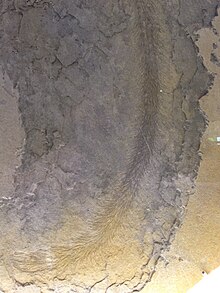巴氏石松属
| 巴氏石松属 化石时期:
| |
|---|---|

| |
| 在澳大利亚维多利亚州发现的巴氏石松化石 | |
| 科学分类 | |
| 界: | 植物界 Plantae |
| 演化支: | 维管植物 Tracheophyta |
| 目: | †镰木目 Drepanophycales |
| 科: | †镰木科 Drepanophycaceae |
| 属: | †巴氏石松属 Baragwanathia W.H.Lang & Cookson, 1935 |
| 模式种 | |
| Baragwanathia longifolia W. H. Lang & Cookson
| |
| 种 | |
|
Baragwanathia abitibiensis | |
巴氏石松(学名:Baragwanathia),又名巴拉万石松,是一属已灭绝的陆生维管植物,生长在潮湿的低洼地区。它们被看作是一类原始的石松门植物。生存于古生代志留纪晚期至泥盆纪早期(427百万年前到393百万年前),和生存于同时期的其他植物相比显得十分“高等”。[2]其化石曾在澳大利亚、 加拿大和中国被发现。本属的名称来自于发现时任维多利亚地质局的主任的名字。[3]
特征
[编辑]巴氏石松的外观为低矮或倒伏生长的柔软草本植物,有着简单的Y型分枝。茎上布满长约1至2厘米的小叶,与星木不同的是巴氏石松的叶中有维管组织,星木的延生叶则没有维管组织,因此并非真正的“叶”。孢子囊位于索状的叶子的轴上,即叶与主茎的连接处,呈螺旋排列,但不会形成球果状的构造。[2]而与巴氏石松同时代的和最亲近的镰木之孢子囊则在专门的叶子的上部。巴氏石松的茎的长度和粗度不同,有直立的也有弯曲的,偶尔有二分的。在叶状茎的下面会有不定根伸出。它们的维管在茎内排列成星状,其管胞排列成原始的环形或螺旋形。叶子长一至二厘米长,不分叉,索状。一根明显的维管螺旋环绕在茎上。 孢子囊宽于长,横向有一道裂缝。配子体目前不明。
争议
[编辑]巴氏石松的生存年代有争议。最早被描述的化石一开始似乎是在志留纪晚期,使得它们似乎和笔石有联系[4]。这使得它们成为当时最先进的植物。但是后来这个定时被推翻,而被推到泥盆纪早期。但是在维多利亚州其它地区被发现的化石被证实是志留纪晚期的。至少到泥盆纪晚期还有巴氏石松出现,它们可能在全球各地均有分布[5]。
物种
[编辑]- Baragwanathia abitibiensis Hueber
- Baragwanathia brevifolia Kraft & Kvaček
- Baragwanathia longifolia W.H.Lang & Cookson
- Baragwanathia sp. Hao & Gensel
参考文献
[编辑]- ^ Rickards (2000)
- ^ 2.0 2.1 Walker, Cyril; Ward, David. Fossils. Smithsonian Handbooks revised, illustrated. Dorling Kindersley. 2002: 295. ISBN 0789489848.
- ^ Lang and Cookson (1935) 425页
- ^ Lang and Cookson (1935) 422页
- ^ Hueber (1983).
参考书目
[编辑]Lang, William H.; Cookson, Isabel C. On a flora, including vascular land plants, associated with Monograptus, in rocks of Silurian age, from Victoria, Australia. (PDF). Philosophical Transactions of the Royal Society of London B. 1935, 224 (517): 421–449 [2012-01-31]. doi:10.1098/rstb.1935.0004.
Hueber, FM (1983) A new species of Baragwanathia from the Sextant Formation (Emsian) Northern Ontario, Canada. Journal of the Linnean Society (Botany) 86, 57-79.
Hao SG and Gensel PG (2001) The Posongchang Floral Assemblages of Southeastern Yunnan, China - Diversity and Disparity in Early Devonian Plant Assemblages. In Plants Invade the Land. Evolutionary and Environmental Perspectives, pp. 103–119. Eds PG Gensel and D Edwards. (Columbia University Press, New York).
Jaeger H (1966). Two late Monograptus species from Victoria, Australia, and their significance for dating the Baragwanathia flora. Proceedings of the Royal Society of Victoria 79, 393-413.
Rickards, R.B. The age of the earliest club mosses: the Silurian Baragwanathia flora in Victoria, Australia (abstract). Geological Magazine. 2000, 137 (2): 207–209 [2007-10-25]. doi:10.1017/S0016756800003800. (原始内容存档于2007-03-11).
